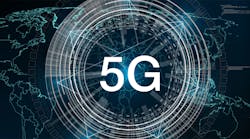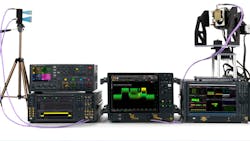Contending in the 5G Race Requires the Right Test Equipment
This article appeared in Microwaves & RF and has been published here with permission.
What you’ll learn:
- The wide-reaching impact of 5G across industry and society
- Top 5G test challenges and solutions
- Key questions to ask about 5G test solutions
Every few years, there comes a wave of new technological advances that transform the world. The concept of 5G, or fifth-generation mobile telecommunication technology, has been around for some time, but it has really caught steam of late.
With wireless network technology becoming indispensable for both individuals and industries, the demand for faster speeds and newer functionalities is only increasing.
The Potential of 5G Across Industries
The significance of 5G technology isn’t restricted to lightning-fast speed either. The incredible internet capacity, response time, reduction in latency (time delay), and diverse new applications that this innovation promises make it even more desirable today.
Ericsson has projected that over 1.5 billion people, or roughly 40% of the world’s population, will gain access to 5G networks in the next four years.
While 4G’s primary scope was limited to telecommunications, 5G is going to be a different ballgame altogether.
Here’s looking at some of the wide-ranging applications of 5G:
- 5G-based IoT
- Mobile networking and telecommunications
- AI-enabled robots
- Medical appliances
- Smart homes
- Defense
- Aerospace
- Self-driven vehicles
- Autonomous industrial equipment
- Agriculture machinery
- Augmented reality (AR)
- Virtual reality (VR)
Given the potential, it’s evident that 5G signal and link testing is going to be of paramount importance in the near future. If we’re to go beyond prototypes and trials, efficient and accurate 5G testing will play a massive role in this area.
How is 5G Different from 4G?
To put it simply, the scope of 5G begins where 4G ends. Things that were once deemed impossible became reality with 4G technology, but there are certain limitations to how much and how quickly data can be transferred.
Security, reliability, speed, and uninterrupted signal strength are the prime benefits that 5G has when compared to 4G.
The real-time transfer of data, with latency in the 1- to 10-ms range, means that 5G will help connect humans and machines like never before. While this improvement in speed might not make a world of difference to the average internet user, it will prove to be game-changing for large-scale critical industrial applications.
5G-enabled automation will create unprecedented opportunities in the commercial ecosphere, leading to higher productivity, and in turn, greater output.
Another remarkable advantage that 5G has over 4G is the easy slicing of the network, which allows for custom speed, capacity, coverage, encryption, and security management.
Top 5G Testing Challenges and Solutions
While the obvious benefits of 5G are indisputable, a wide range of challenges need to be addressed before it can be adopted across markets. Because 5G will deliver unparalleled speed, the demands on the network-testing regime will be proportionally higher. And, therefore, testing of 5G equipment and networks assumes significance.
Some of the most pressing concerns include:
- Millimeter-wave (mmWave) adoption: Perhaps the biggest challenge faced by engineers working on futuristic systems and wireless networks is to develop the millimeter-wave infrastructure in a streamlined and cost-efficient manner.
- Assessing beamforming performance: Conducting static tests on devices or antennas in active beamforming environments (beam tracking and switching), and gauging the performance, will also be key to helping massive MIMO arrays use nearby spectrum. This will include measuring and recording field beamforming characteristics and identifying the top issues.
- Validating modulation and channel quality: In a 5G environment, monitoring the channel bandwidth, channel center frequency, and channel stability is essential. Configuration and performance indicators like bandwidth, frequency, and stability will need to be monitored.
- Radio-frequency performance: Instant troubleshooting and identifying the root cause of poor RF performance will play a massive role in the analysis and testing process.
Apart from those challenges, running all relevant tests quickly and efficiently is necessary to keep the test throughput cost-effective. The next step in this domain will be to find out ways to enable machine-learning-based automation for 5G system testing and deployments.
To take this technology from the lab to the field, the accuracy and efficiency of 5G testing are major factors for consideration. Automated testing and analysis, a solid fiber foundation, and reliable support are among the biggest concerns in this space. The role of test equipment, thus, is massive in the 5G industry.
The Right Testing Solutions for 5G
When considering the right testing solutions for 5G, it’s important to bear in mind that this isn’t a one-size-fits-all case. Because the applications and use cases are so varied in nature, the complex 5G testing environment calls for various testing equipment that meet your unique needs.
Whether you talk about high-end testing tools like signal generators, spectrum analyzers, vector network analyzers, oscilloscopes, or power meters, here are the most critical questions you must ask:
- Does the testing solution offer relevant features?
- How scalable is the solution, keeping future needs in mind?
- How cost-effective is the technology and does it fit your budget?
- · Is it the perfect fit for the challenges you’re trying to resolve?
- Is the solution available for rent or lease?
- Has it been manufactured by a reliable company?
- Does the vendor offer optimal customer support?
Your 5G test-equipment procurement plan should be able to answer these questions. 5G’s promises of higher network capacity, increased bandwidth, lower latency, and reduced battery consumption for the wide-scale adoption of IoT applications can’t be realized unless testing is done right.
5G deployment will soon be a reality—make sure you have the right test equipment to stay a step ahead in the 5G race.
Amanda Wilson is an established freelance writer who has built her career focusing on the electrical and electronic test equipment and measurement industry.

